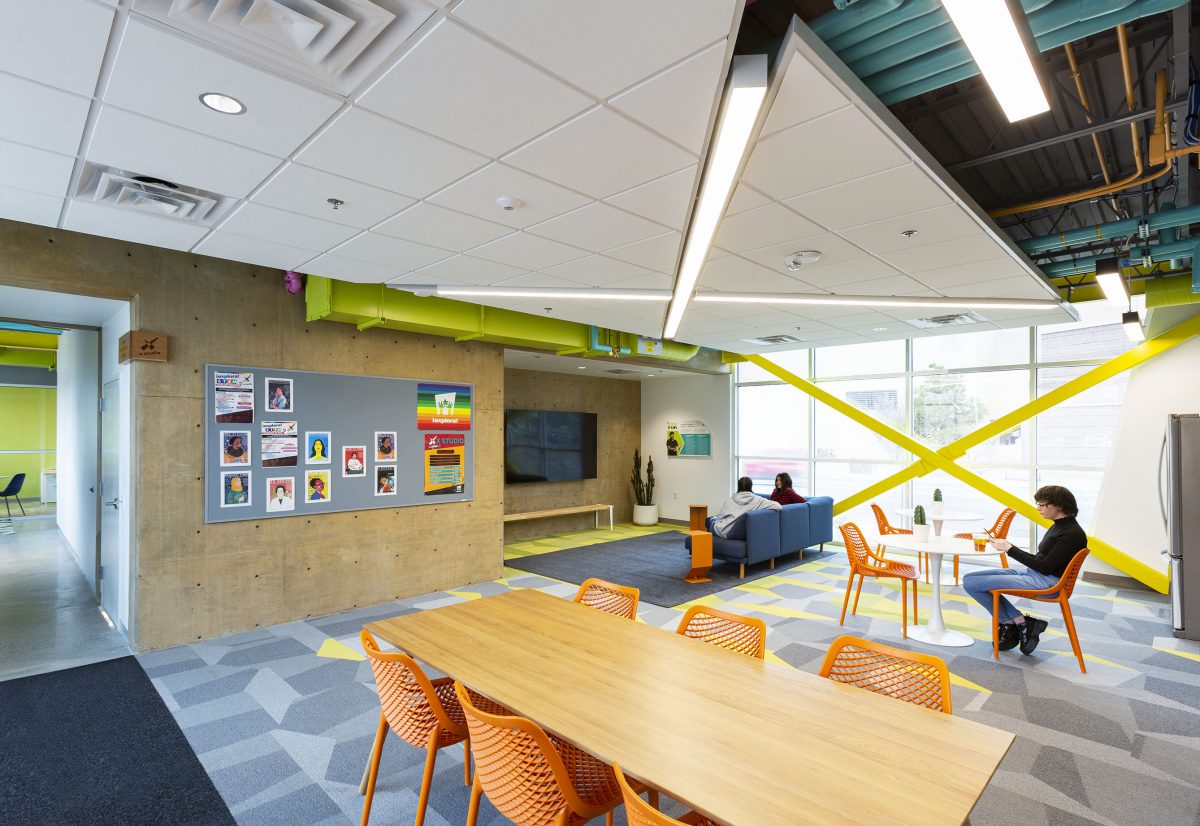By: Ambrose Martinez
The practice of architecture has been around for centuries and the people in this practice have accomplished multiple milestones for human intuition and engineering feats. From amazing ancient civilizations to cloud-touching skyscrapers, what can’t we accomplish when we put our mind to something? Well, now architecture faces a new task – a task that is beyond the building, the structure, and the physical form –a task where we need to think about the environment, life cycles, smart material selection, and human health. You may think we can accomplish this by only participating in a “sustainable” project, but this is not true – we can accomplish sustainable design by starting with the basics and being conscious of the materials and finishes we are utilizing in our buildings. This includes but is not limited to:
- Material extraction and transportation
- Impact on human health through material processing
- Impact on the well-being of the end user
- Impact on communities (i.e. does the factory treat its employees well or are they complicit in violating labor laws?)
- The resilience of a material (its lifespan)
- Its end-of-life strategy (how can it be reasonably disposed of or reused)
…and many other factors that can come into play when dealing with materials and overall healthy choices for humans and the environment. We don’t all have the luxury of working on large, environmentally motivated projects – but understanding and implementing more sustainable design choices on our projects is just as beneficial in the long-run.

Sustainable architecture is nothing new in our industry and the idea of being “green” has been around for quite some time. The term “sustainable design” gained meaning after the 1987 UN-commissioned study known as the Brundtland Report which stated: “Humanity has the ability to make development sustainable to ensure that it meets the needs of the present without compromising the ability of future generations to meet their own needs.” In 1989, a Kansas City architect named Bob Berkebile petitioned the American Institute of Architects (AIA) to establish a committee to study and promote ways that the profession could become more eco-friendly. Sustainable design strategies have been used since ancient times and throughout indigenous architecture – but this along with other innovative thinkers started the modern movement in the late 1980’s for sustainability that we associate “green design” with for today’s projects.
This movement challenged people to design buildings with the environment, and our planet’s future, in the forefront.
Throughout the history of sustainable design in architecture, we have seen so many great ideas and actual built structures answer the call to this issue. Glenn Murcutt’s Magney House built in 1984 in Australia, while small, uses materials and building orientation to respond to site specific conditions. The Northern and Eastern facades are entirely glazed, allowing winter sunlight to penetrate and warm the spaces. In the summertime, the operable exterior blinds block the light from entering and allow the insulated concrete floor and RVB walls to keep the interiors cool. The much larger Sun-Moon Mansion, completed in 2010 by architect Huang Ming in China a large array of solar panels to power energy-saving technologies, such as solar-powered hot water supply, heating, refrigeration, and photovoltaic power generation, which boosts its energy-saving efficiency to 88 percent. Both projects serve as examples of successfully designing and being environmentally responsible regardless of size.
UNDERSTANDING THE SUPPLY CHAIN FROM BEGINING TO END
Even the famous architect Frank Lloyd Wright between the 1900s-1960s, before the term “sustainable design” became popular, was designing buildings with concerns of energy consumption and wanting his designs to be in harmony with its surroundings and environment. You can even find examples of intuitive eco-friendly design all the way back to ancient times, such as the ethereal Angkor Wat temple complex in Cambodia. It had various water bodies that helped keep it cool, temple structures designed to provide a constant and easily accessible supply of groundwater, used indigenous materials for the entire structure of the complex. So, what makes it so different now? Why do we need to see sustainability in a new way when designers, engineers, and architects have been doing this for years? Just like any other great idea in our history, we lose track of the main goal and often find ourselves taking the easy route without crossing our T’s and dotting our I’s.
So, what is the solution? The solution is a call to architects and designers to simply make more conscious decisions/selections in their design process, such as selecting items that have less emissions and/or have a longer life cycle and researching the manufacturers and making sure what they are doing is ethically and environmentally responsible. While working on the next big sustainable project would be incredible – what if the project is a simple office renovation or a typical two-bedroom home in a suburb? Regardless of the type of work you receive, even small, simple projects deserve attention to sustainable details. Each project is unique and should respond to the needs of its place, occupants, and client, but each project is an opportunity for environmental stewardship. We also need to be aware and conscious of our material selections for projects when dealing with clients or owners that only have budgets for the “typical” materials and projects we see every day.
What do I mean by typical and everyday projects? It’s the shopping mall and retail buildings, the dentist office or the banks, the apartment buildings, and the residential homes we see all over our cities. Of course, at times clients and owners may feel they don’t have the luxury to do the latest and greatest things to be “green”. Therefore, we can do some of our own research and be our own sustainable scientist to break the mold of what I see as an issue in today’s architecture industry. It’s all too easy to default to specifying the same standard materials our industry has used historically rather than making mindful decisions about what should and shouldn’t be included in a building’s construction. Being within budget is obviously extremely important, so I’m not saying to toss that out the door. However, I am saying we need to get out of the box of always picking the same insulation, floor, wall and ceiling finishes, paints, wood frames, coatings, membranes and many more elements of building construction without batting an eye.
There’s much more we can do to be sustainable in our processes and design ideas while being budget conscious and meeting our client’s goals.
How do we accomplish this you ask? We need to be spending more time looking for answers beyond the standard material suggestions and then educating our clients and design and construction teams of the alternatives. For example, insulation is one of the most frequently used products and typically specified with the most reasonably priced product on the market. Upon closer inspection, there are several alternates that have better life-cycles, have more sustainable R-Values, and use less harmful chemicals in their manufacturing process – such as the insulation called ThermaCork which has a negative carbon footprint, because the finished product is made from the outer bark of oak trees. It is natural, renewable, recyclable, and biodegradable, plus it cancels noise and is free of toxins.
When it comes to wood finishes or paints, are the manufacturer’s recycling their wood? Are the coatings they are using off-gassing VOCs and unsafe for humans to breathe? Are the paint companies using dangerous chemicals or do they have safe innovative ways to make their paints? A paint company known as CLARE has paint they produce that has no VOC off-setting, no hazardous air pollutants, no toxic air contaminants, and no EPA chemicals of concern. Even knowing this, we still tend to specify the typical paint products in our projects knowing these harmful chemicals are inside of them.
Another thing to consider is: how are all these materials being processed from start to finish? Producing cement or a CMU block is a very harmful process because of the chemicals and materials needed to make it, but a company by the name of Prometheus Materials combines microalgae with water, sunlight, and CO2 to create a bio-cement. Essentially, they are using natural materials and environmentally safe processes to create blocks and solid surfaces.
Sometimes we aim for sustainable design by having our building stamped with accreditations like LEED (Leadership in Energy & Environmental Design) or the WELL Building Standard. These are both great programs, and they consider materials, site, energy etc., but again – many projects don’t have the opportunity to try and accomplish “green” accreditations. Even so, why should not having a project with accreditations stop us?

WHERE DO PRODUCTS COME FROM?
What about thinking about where you’re getting your products from? Another aspect of identifying sustainable materials and building products is to consider where the product is being produced. For instance, it might make sense to use a local alternative to reduce transportation emissions. Finding local products can be difficult at times, but these and many more questions are all crucial questions that you need to ask yourself for any project.
In 2013, YGH Architecture from Portland, Oregon wrote a letter to manufacturers saying they would no longer specify materials without a Health Product Declaration (HPD). They eventually want to eliminate all Red List Materials from their specifications and only specify from manufacturers whose products have HPDs and Environmental Product Declarations (EPDs). This is only one way to be proactive, but whatever route you take – we will probably find some manufactures that are better than others when it comes to sustainability and probably be surprised by the good, the bad, and the ugly you find from this researched information. Some of the “ugly” may include terrible working conditions for employees producing these materials and people living by these manufacturer’s, which has deadly health effects for both worker and user. In an article titled “Equity and Social Justice in the Supply Chain”, written by Diana Alley, Avideh Haghighi and Lona Rerick, three design and architect professionals from ZGF Architects – they discuss the impact of materials from production to user, and even to people outside of the design circle like a fireman that has to put out a fire in the building and the terrible gases and fumes these materials are offsetting from that fire. It’s truly about this whole idea of seeing the big picture and thinking about the “supply chain”. It’s important we all understand this chain from the beginning to the end. It’s likely you will find more innovative manufacturers making materials that work just as good if not better than others, and they are practicing in the same mindset we are when it comes to the environment and health for humans.
This is inspiring! Wouldn’t it be great if we were able to hold the companies accountable for the products they make and distribute? Just as architects are held accountable for the health, safety, and welfare of the public…so should those designing and creating the products we are using every day to build our towns, cities, and communities. There are many materials being manufactured today in a healthy sustainable way for almost anything you can think of, we just need to do the research. A building that has great form and function, as well as a healthy response to the environment, sustainable construction, and is safe for the end user – is what our industry should strive for with every single project we take on.
This may take some time and effort on the individual, but isn’t that why we signed up to be architects, engineers, and designers? As architects, engineers, and designers it is our responsibility to use our problem-solving skills and access to information to find the best solutions within reason and budget. Instead of copy and pasting the typical elements into our projects just because they work, we can start to shift the baseline with more informed selections. Maybe you focus on a single material division and really dig in to researching a few alternatives. Or maybe you start a committee at your firm that is focused on creating a “green list” of better materials. Whatever the path, it is important that we share the knowledge we gain. I truly believe it will make us better thinkers and creators.
Just as architects are held accountable for the health, safety, and welfare of the public…so should those designing and creating the products we are using every day to build our towns, cities, and communities.
Of course, we need to design great and functional buildings – but we should also research from dirt to solid form, cause and effect from the production, transportation, installation, as well as the users and others involved, all the way to end-life (or re-use). We need to truly understand the full story of what we are installing into our buildings and not see it as just another spec note on our drawings and make smart decisions as well as inform and educate our clients. Even if it makes a microscopic dent of a difference like putting one soda can into a recycle bin – every decision matters. We can control the materials and finishes that come in and out of our projects, regardless of the size of the project, and make a choice.
Your project may not be the next big thing in a magazine, but what you’re doing my friends, is having a conscious mind, and creating sustainable design.
 Ambrose Martinez
Ambrose Martinez
Project Designer
Ambrose is a Project Designer with Studio Southwest Architects and assists with the design of projects using AutoCAD, and BIM software. Ambrose is also proficient in VectorWorks 2016, Rhinoceros 5.0, 3D Modeling, and a range of Adobe products including: Illustrator, InDesign, and Photoshop.



